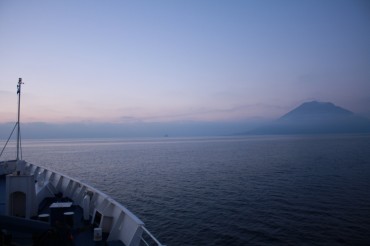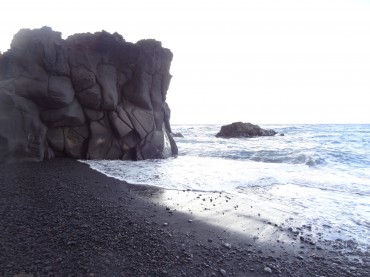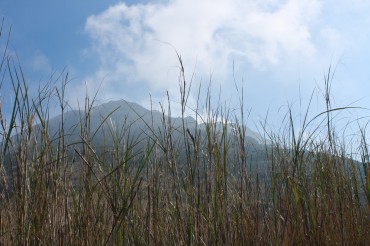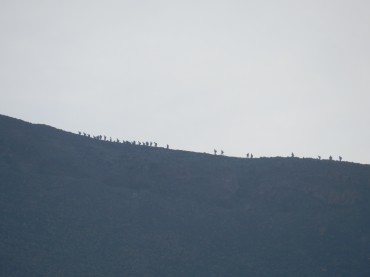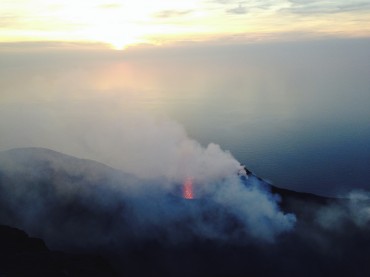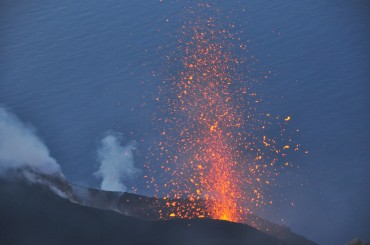17.7.2014 – Issue 15 - Fire – Schmidlin Chasper, von Mackensen Till – Videos, Studio, Essays
Journey into the Fire
Essay by Chasper Schmidlin, Video by Till von Mackensen
A journey with our students took us to a place where fire could be
experienced with all the senses: the volcanic island of Stromboli, one
of the pearls of the Aeolian Islands in the Mediterranean Sea. To get
there, we had to cross the deep blue sea. The boat bore the name
Eraclide. It made us think of the philosopher’s doctrine, according to
which fire was the reason for the existence of all things; a fire which,
like the sun, continually rejuvenates and dies. Accordingly, all was in
flow: panta rhei.
We began our journey following the lifecycle of the sun; when it set
in the port of Naples, then, we slept to the steady pace of the boat
throughout the night and awoke with the sun’s rise in Stromboli. In the
shadow of the sun’s early rays we vaguely recognised the fire-breathing
mountain surrounded by cobalt blue waters and a secretive mist.
Like an animal, it rose up from its aquatic surroundings. Almost like
processing a photograph, the blurring of the mountain with the water,
the clouds and the sky faded away, slowly to give it a more concrete
form. Finally, the 926-metre high monster revealed itself, while at the
seashore the contrast between the white foam of the sea and the
black lava rock was as sharp as it could be. Once again, the island was
becoming more tangible against this white canvas.
He hisses, puffs, snorts and gurgles: Stromboli is a very active being—
and its ascent not for the faint-hearted. The conquest of this
‘Lighthouse of Antiquity’ takes about four hours. In the afternoon, we
set out. In the narrow streets of the village, lined by simple white cubic
houses, everyone greets everyone, because everyone knows everyone.
Multi-coloured flowers and lemon trees light up the palm gardens
with yellow and orange hues. From down here, the volcano looks quite
harmless. Left, past the church, we continue on a paved winding path
and then stomp through a dusty ravine. The first few hundred metres,
we are surrounded by tall bamboo. We can no longer see the volcano,
but we can still hear and smell it. Above the vegetation line, the path
steeply climbs the hill’s edge. The volcano greets us with cool air and a
more intense smell of fire. The higher we climb, the more glorious the
view back towards the village and the sea; a view over flowering gorse
and cistus on the steep lava flanks. At sunset, we reach Hell’s Theatre
lodge, close to the peak. The last few metres lead over bare, grey ash
fields. One can perceive white fumes, dust and an ever intensifying
hiss. The dull thunder of the eruptions sounds threatening; the smell of
sulphur is intense. Finally, we emerge into a natural spectacle with the
sun, the sound and reflection of the blue sea, the coloured clouds and
the sparkling fire, this elemental force and the protagonist of the place.
The sun burns. The clouds reflect its light in the sky. Flaming colours
match its rays; they stretch out to the horizon until the horizon engulfs
the shining disc. The red fire of the volcano grows more intense as
the sun descends, its glowing beauty more visible in the gathering
darkness. Red and yellow like the unquenchable force of the earth, the
volcano spits and smokes with rhythmic motion, the lava that is thrown
up landing just in front of us. Large fire fountains shoot out of the crater
at fifteen minute intervals, the lava brimming over its rim. Dark by now,
the stars shine above us, while the hardened lava rock on which we sit
is pleasantly warm. Every few minutes, a further eruption quenches
our thirst for this ember rain. We wrestle with words, so powerful is the
spectacle before us. I realise that magma is the synthesis of everything.
The fire of the sun appears in the fire of the volcano. The light of
the fire is offset by the darkness of the night and sea. Eventually, the
fire fountains calm down, the clouds of smoke dissipate and a wonderful
silence returns. We take a different route back to the valley, one
straight down a lava field towards the sea.
Download article as PDF


